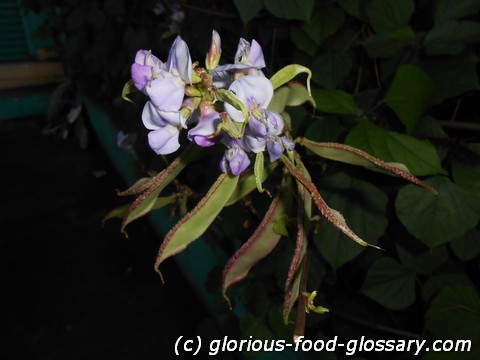English: Lima bean / Deutsch: Tarhonyabohnen / Español: Frijol Lima / Português: Feijão-Lima / Français: Haricot de Lima / Italiano: Fagiolo di Lima /
In the food context, "Bataw" refers to the hyacinth bean or lablab bean (Lablab purpureus), similar to "Batao," and is used extensively in Filipino and other Southeast Asian cuisines. Bataw beans are known for their distinctive taste and nutritional value, making them a popular ingredient in various dishes.
Culinary Uses:
- Fresh Pods: The young, green pods of the bataw plant are often cooked and eaten as a vegetable. They can be added to soups, stews, and mixed vegetable dishes, similar to how one might use green beans.
- Seeds: The mature seeds are also edible but require thorough cooking to neutralize any potentially harmful substances. They can be used in soups and other dishes where beans are typically used.
- Leaves: In some culinary traditions, the leaves of the bataw plant are used as a leafy green vegetable, either cooked or sometimes raw in salads.
Nutritional Aspects:
Bataw beans are rich in protein, dietary fiber, vitamins (such as vitamin A and C), and minerals (including iron and potassium). They offer a range of health benefits, from improving digestion to supporting heart health.
Cultural Significance:
Bataw is not only valued for its taste but also for its role in traditional and rural cuisines, where it's appreciated for its adaptability to different growing conditions and its contribution to dietary diversity and food security.
Preparation and Safety:
Proper preparation of bataw, especially when dealing with mature seeds, is crucial. The seeds contain certain compounds that can be toxic if ingested in large amounts or if not properly cooked. It's recommended to boil the seeds thoroughly and discard the water to ensure safety.
Summary
Bataw, or the hyacinth bean, is a versatile ingredient in Filipino and Southeast Asian cooking, known for its nutritional benefits and distinctive flavor. Whether used in its pod, seed, or leaf form, bataw adds a unique touch to a variety of dishes, contributing both taste and nutrition to the culinary landscape of the region.
--
Referred Picture:

Related Articles to the term 'Bataw' | |
| 'Batao' | ■■■■■■■■■■ |
| In the food context, \'Batao\' refers to a type of bean commonly used in Filipino cuisine, also known . . . Read More | |
| 'Green Beans' | ■■■■■ |
| Green Beans, in the food context, refer to the unripe or young pods of the bean plant that are consumed . . . Read More | |
| 'Loofah' | ■■■■■ |
| Loofah in the food context refers to the edible fruit of plants in the genus Luffa, particularly the . . . Read More | |
| 'Kasubha' | ■■■■ |
| Kasubha is the dried stigmas of a plant, used for coloring and flavoring food a kind of saffron. . . . . . Read More | |
| 'Calamar' | ■■■■ |
| Calamar in the food context refers to squid, a marine mollusk that is widely consumed in various cuisines . . . Read More | |
| 'Nilagang Gabi' | ■■■■ |
| Nilagang Gabi in the food context refers to a Filipino dish involving boiled taro (gabi) root. Taro is . . . Read More | |
| 'Paa ng Manok' | ■■■■ |
| Paa ng Manok in the food context refers to chicken feet, a delicacy and common ingredient in various . . . Read More | |
| 'Talbos' | ■■■ |
| Talbos is the Filipino generic name for \'young tips of edible leaves\', such as Talbos ng Kamote young . . . Read More | |
| 'Rice' | ■■■ |
| Rice is the seed of the monocot plants Oryza sativa (Asian rice) or Oryza glaberrima (African rice). . . . Read More | |
| 'Curry' | ■■■ |
| Curry: A curry is a dish with a sauce seasoned with spices, mainly associated with South Asian cuisine. . . . Read More | |
